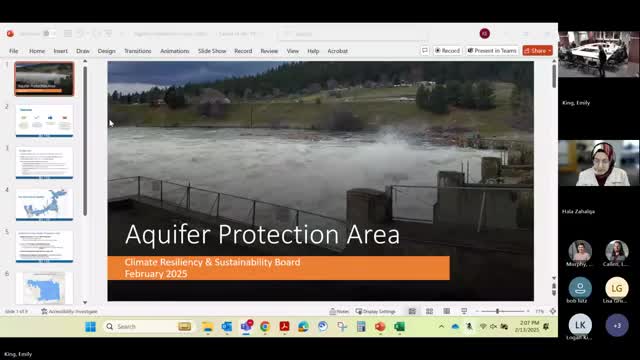City staff outlines option to rejoin county aquifer protection area; board signals support to draft resolution
February 15, 2025 | Spokane, Spokane County, Washington
This article was created by AI summarizing key points discussed. AI makes mistakes, so for full details and context, please refer to the video of the full meeting. Please report any errors so we can fix them. Report an error »

Marlene Weist, a city staff presenter, told the Community Resilience and Sustainability Board that the city has “an opportunity to join the county in what’s called an aquifer protection area.” The county’s authorization for the APA expires at the end of 2025, and the county plans to ask voters to renew it; the city would need to adopt a resolution and an interlocal agreement to be on the ballot.
Why it matters: The APA revenue is dedicated to groundwater protection, monitoring and education. Weist said the county’s current fee structure charges about $15 per year for residential properties connected to the municipal water system and an additional $15 per year for properties served by on‑site sewage systems, and that those fees fund projects such as septic-system removal, monitoring, stormwater controls and public education. Weist also estimated the city’s share of revenue at roughly “1.8 ish million, perhaps on an annualized basis if the rate is kept that same $15 per residential unit.”
What staff presented: Weist described the Spokane Valley–Rathdrum Prairie Aquifer as the region’s sole-source aquifer and reviewed potential uses for APA funds, including monitoring groundwater quality (PFAS and legacy contaminants were mentioned), stormwater and wastewater investments, and projects to make wells and well sites more resilient to projected climate impacts. She noted the city currently delivers up to about 50,000,000 gallons of water per day in summer peak conditions and that some well infrastructure is shallow relative to future resilience needs.
Board discussion and next steps: Board members asked about trade-offs (whether deeper or more wells would be the response to reduced recharge) and about equitable cost allocation for customers outside city limits served by city water. Weist said the city already serves Airway Heights under a long‑term arrangement and described capital contributions from that jurisdiction; she characterized the current capital arrangement as involving a $15,000,000 capital investment from Airway Heights toward system improvements (as stated by staff during the meeting).
After discussion, staff asked whether the board would like them to draft a resolution for the board’s consideration at the next meeting. No formal vote was taken; the board indicated there was interest in moving forward and staff said there is room on the March agenda to consider a draft resolution and an interlocal agreement. The meeting record therefore shows a direction/assignment rather than a formal decision.
What was not decided: The board did not vote to join the APA, and no final interlocal agreement or ordinance was adopted during the meeting. Any city participation would require a future council resolution and then a voter decision under county ballot procedures.
Ending note: Staff said they would prepare materials and a draft resolution for the board’s review next month to clarify costs, proposed uses and the text of an interlocal agreement for council consideration.
Why it matters: The APA revenue is dedicated to groundwater protection, monitoring and education. Weist said the county’s current fee structure charges about $15 per year for residential properties connected to the municipal water system and an additional $15 per year for properties served by on‑site sewage systems, and that those fees fund projects such as septic-system removal, monitoring, stormwater controls and public education. Weist also estimated the city’s share of revenue at roughly “1.8 ish million, perhaps on an annualized basis if the rate is kept that same $15 per residential unit.”
What staff presented: Weist described the Spokane Valley–Rathdrum Prairie Aquifer as the region’s sole-source aquifer and reviewed potential uses for APA funds, including monitoring groundwater quality (PFAS and legacy contaminants were mentioned), stormwater and wastewater investments, and projects to make wells and well sites more resilient to projected climate impacts. She noted the city currently delivers up to about 50,000,000 gallons of water per day in summer peak conditions and that some well infrastructure is shallow relative to future resilience needs.
Board discussion and next steps: Board members asked about trade-offs (whether deeper or more wells would be the response to reduced recharge) and about equitable cost allocation for customers outside city limits served by city water. Weist said the city already serves Airway Heights under a long‑term arrangement and described capital contributions from that jurisdiction; she characterized the current capital arrangement as involving a $15,000,000 capital investment from Airway Heights toward system improvements (as stated by staff during the meeting).
After discussion, staff asked whether the board would like them to draft a resolution for the board’s consideration at the next meeting. No formal vote was taken; the board indicated there was interest in moving forward and staff said there is room on the March agenda to consider a draft resolution and an interlocal agreement. The meeting record therefore shows a direction/assignment rather than a formal decision.
What was not decided: The board did not vote to join the APA, and no final interlocal agreement or ordinance was adopted during the meeting. Any city participation would require a future council resolution and then a voter decision under county ballot procedures.
Ending note: Staff said they would prepare materials and a draft resolution for the board’s review next month to clarify costs, proposed uses and the text of an interlocal agreement for council consideration.
View full meeting
This article is based on a recent meeting—watch the full video and explore the complete transcript for deeper insights into the discussion.
View full meeting
